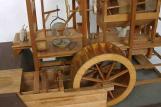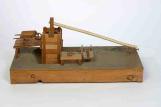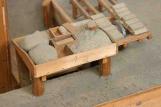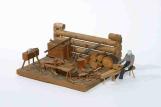2
OLD PICTURE OF GRIST MILLThe first industry that was needed in a settlement was a grist mill to grind into wheat and flour the grain grown by the settlers. In 1825 William Cottingham, at the age of 18, set up a grist mill in Omemee at the dam on the Pigeon River. Prior to this, settlers made the long journey to Millbrook often with a bag of wheat on their shoulders. The mill was rebuilt in 1872 and was generated by a water wheel. William Jr. managed the mill until 1878 when Thomas Stephenson purchased it. In 1880, John Beatty rented the mill, until Thomas Stephenson's sons could take over the business, followed by Stephenson's grandsons until the mill was destroyed by fire in 1972.
Grist mills relied heavily on water, and prior to the building of the original mill, there must have been a dam built across the river. From time to time it was washed away by spring floods. The following is from the CANADIAN POST, April 30, 1883:
"A Freshet - Quite a stir was occasioned in Omemee on Sunday afternoon when it became known that the embankment which damned the river was swept away by the large pieces of ice passing over. The bridge across the river below narrowly escaped being carried away also by the current and floating ice. All the mills have ceased running for want of water."
4
GRIST MILL MODELThe working model of a pioneer grist mill is one of the largest models in Mr. McCrea's collection. With the use of "cut away parts" one can see how the wheat was ground into flour, shorts and bran.
In short, an elevator takes the wheat by belt and bucket to the scouring machine. Cleaned wheat drops into the hopper, and from there into a flexible jointed pipe under the floor, and to the hopper above the millstones. The ground grain is cooled and moves along the elevator up to the bolting machines. The miller's fee, set by the government, was ½ of each bushel of wheat. The millstones were often made in France and were of several pieces, fitted, cemented and held together with iron hoops. Eventually millstones were made in Canada and many survive to this day, decorating a garden or landscape.
6
PULLEYS - GRIST MILLThe attention to detail by Mr. McCrea is shown in the pulleys and belts within his model of the grist mill. Fabric belts smoothly move on the pulleys as they would in the actual mill.
8
BRICK MAKINGIn 1877 George Hawkins opened a brickyard on the east side of the river. It is not know how long this trade continued, although it appears that it lasted at least three generations.
It was necessary to first have the brick clay mellow and this was accomplished by leaving the clay out from fall to spring in piles or ridges. The following spring the clay was dumped into a pug mill where enough water was added to temper it. The model shows the mill with the horse drawing tongue.It was placed in molds and then moved to the drying shed. When the bricks were dry, they were moved to a spot to be burned for one hundred and forty-four hours.
Many of the older buildings in Omemee are of brick construction. Perhaps most of the bricks that went into these were made within the district - Lindsay, Peterborough, or in Omemee. There was a Curtis brick works on the Warsaw Road, just east of the canal bridge at Peterborough and it is thought that there was also a brickworks south of Lindsay. It was an industry that was required in all areas and traces of the early brickyards are difficult to find.
10
BRICK MOULDSThe brickmaker shaped his bricks much as the baker shapes the loaves of bread. The wet clay was slammed into a mould and then the surface leveled of surplus clay. Sand was sprinkled over the mould which was turned out on a palette and then on a barrow. This would be put in the drying shed in tiers for the time needed and then removed for burning. When the bricks were dry they were wheeled to the spot where they were to be burned. Wood was then used for fuel and it took one hundred and forty-four hours to burn the brick properly.
12
SHINGLE MAKINGIn order to have shingles for his home and farm buildings, the pioneer often had to make these himself. A corner of the barn might be equipped for the indoor task of making shingles. White pine logs were the preferred wood and they were sawn into 18 inch length and split into quarters. Shooks of ½ inch thickness were reeved off. Then the shingle maker took away and shaped each shingle. The finished shingles could be from 4 inches in width to 10 inches and were about 7/16 thick at the butt and about 3/32 inches in width at the top. The shingles that were headed for sale would be packed in bundles of 1,000.
14
LIME KILNLime was needed by the settler for mixing with sand to chink the early log homes. The kilns were often built into the side of a hill or small elevation. A kiln was quite large - about 15 feet in diameter and had to be line with a thick wall of mortar and stone that would not crack with intense hear. The bottom of the kiln was concave and about a foot above the base of the kiln, an opening was left for stoking the fire. Lime would also be removed through this opening. Flat stones were placed in the bottom of the kiln and limestone was placed on these stones. The fire was stoked and had to be kept burning day and night. It took several days for the kiln to reach a sufficient heat and then took virtually as long to cool down. Once cool, the lime was removed.
The kiln would be stoked with wood that was unsuitable for construction and it took a great quantity of wood to bring the heat up sufficiently to extract the lime.






